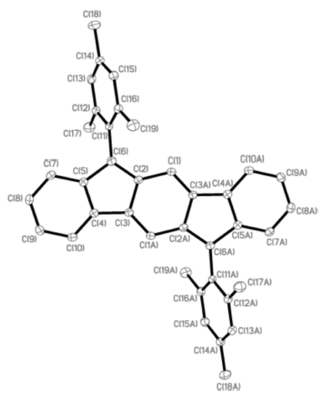Mar 19 2013
University of Oregon chemists have synthesized organic molecular structures that move both positive and negative electrical charges — a highly desired but often difficult combination to achieve in current efforts to create highly flexible electronic devices and other new-age technologies.

Aaron Fix and Parker DealThe research utilized a family of readily available and inexpensive hydrocarbons known as indenofluorenes to build molecular scaffolding for integrative circuitry. An indenofluorene-derivative framework, said co-author Michael M. Haley, head of the UO Department of Chemistry, offers more simplicity, flexibility and affordability than that available using many other hydrocarbon-based approaches.
Haley's lab in the UO's Materials Science Institute reported a linear version of the new molecular structure in the Journal of the American Chemical Society last June. For the new paper — placed online in advance of regular publication in the ACS journal Organic Letters — Haley's team manipulated that infrastructure into a more bent architecture and tested some of its fundamental optical and electronic properties.
Bent-shaped X-ray structures detailed in new paperUsing organic molecules is helping materials scientists move beyond silicon semiconductor technology, said Aaron G. Fix, a doctoral student in Haley's lab and lead author of the new paper. "You don't need to lay the molecules on silicon. They can be laid on plastics and other materials, as long as you have the necessary metallic or graphite contacts," he said. "These new materials will allow for electronics that can take on stresses at levels traditional silicon, which is brittle, cannot handle. We will be able to make stretchable and bendable devices."
Original linear X-ray structure from 2012 paperA lot of different materials can be used in organic electronic devices, Fix said. Most of them, he added, move positive charges well but not negative charges. "We are trying to fill that niche by developing materials that can do that well," he said.
Researchers pursuing devices utilizing organic semiconducting technology already are envisioning applications from roll-up computers to synthetic skin for robotic and prosthetic applications. Similar research done elsewhere with such approaches has surfaced in some smart phones and television screens.
"Specifically, we are doing research on transporting electrons using these indenofluorene materials for building integrated circuits for computers," said co-author Parker E. Deal, who worked in Haley's lab on both projects as an undergraduate chemistry major in the Robert D. Clark Honors College at the UO. "This is fundamental research in that these are new molecules that nobody has made before, and we are studying them to see how effective they are and how they may further our improvement of these materials to build cheap, flexible devices."
The project, Haley said, is "old-school chemistry" and uses no precious metals. These hydrocarbons, he said, are cheap and easily manipulated for creating artificial materials. "And we have shown that we are able to prepare the materials in gram quantities with good overall yields and excellent purity using methodologies that should work in large-scale production," he said.
Haley's team is about to work with an outside collaborator to test the new scaffolding in an electronic device. If successful, Haley said, work on the approach can move forward.
"This research by Dr. Haley and his team promises to open a whole new world of possibilities for scientists and innovators," said Kimberly Andrews Espy, vice president for research and innovation at the University of Oregon. "Researchers at the University of Oregon continue to solve today's challenges through the development of tools and technologies that will redefine our future."
The National Science Foundation supported the research (grants CHE-1013032, CHE-0923589 and OCI-0960354). Co-author Bradley D. Rose, a doctoral student, worked on both projects under the Emmanuil Troyansky Fellowship of the American Chemical Society.
Additional co-authors were graduate student Chris L. Vonnegut and Lev N. Zakharov of the UO-based Center for Advanced Materials Characterization in Oregon (CAMCOR).